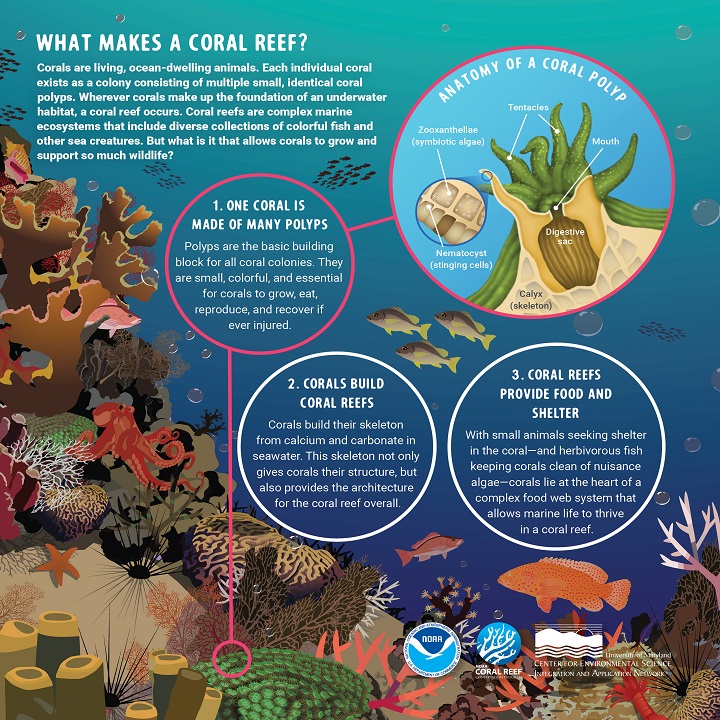- ABOUT US
- PROGRAM AREAS
- CONSERVATION APPROACH
- EDUCATION
- MULTIMEDIA
- Zooxanthellae = symbiotic algae
- Nematocyst = stinging cells
- Tentacles
- Mouth
- Digestive sac
- Calyx = skeleton
What Makes a Coral Reef?
This infographic describes the anatomy of a coral polyp and how polyps form reef structures.
This infographic was made in collaboration with the University of Maryland Center for Environmental Science Integration and Application Network.
Visit the National Coral Reef Monitoring Program's page for all U.S. coral reef status reports.

Download infographic PDF: English version
Download infographic PDF: Spanish version
Infographic Transcript: What Makes a Coral Reef?
Coral reefs are living, ocean-dwelling animals. Each individual coral exists as a colony consisting of multiple small, identical coral polyps. Wherever corals make up the foundation of an underwater habitat, a coral reef occurs. Coral reefs are complex marine ecosystems that include diverse collections of colorful fish and other sea creatures. But what is it that allows corals to grow and support so much wildlife?
Anatomy of a Coral Polyp
1. One coral is made of many polyps
Polyps are the basic building block for all coral colonies. They are small, colorful, and essential for corals to grow, eat, reproduce, and recover if ever injured.
2. Corals build coral reefs
Corals build their skeleton from calcium and carbonate in seawater. This skeleton not only gives corals their structure, but also provides the architecture for the coral reef overall.
3. Coral reefs provide food and shelter
With small animals seeking shelter in the coral—and herbivorous fish keeping corals clean of nuisance algae—corals lie at the heart of a complex food web system that allows marine life to thrive in a coral reef.
About Us

The NOAA Coral Reef Conservation Program was established in 2000 by the Coral Reef Conservation Act. Headquartered in Silver Spring, Maryland, the program is part of NOAA's Office for Coastal Management.

The Coral Reef Information System (CoRIS) is the program's information portal that provides access to NOAA coral reef data and products.
Work With US
U.S. Coral Reef Task Force
Funding Opportunities
Employment
Fellowship Program
Contracting Assistance
Graphic Identifier
Featured Stories Archive

Access the archive of featured stories here...
Feedback
Thank you for visiting NOAA’s Coral Reef Conservation Program online. Please take our website satisfaction survey. We welcome your ideas, comments, and feedback. Questions? Email coralreef@noaa.gov.
Stay Connected
Contact Us
NOAA’s Coral Reef Conservation Program
SSMC4, 10th Floor
1305 East West Highway
Silver Spring, MD 20910
coralreef@noaa.gov
